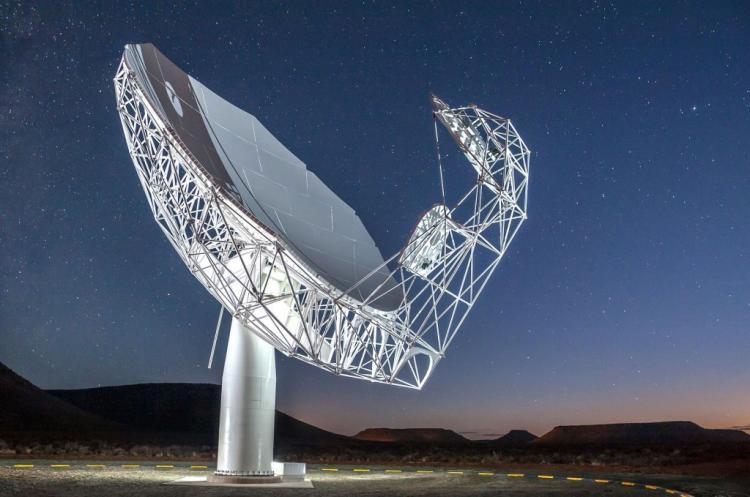Megamasers are the Bat-Signals of the cosmos-borne out of the collision between two galaxies like the Milky Way, these astronomical beacons shoot beams of microwave radiation far into space, not unlike spotlights shining on a city skyline.
Now, an international team of researchers led out of South Africa, and including astrophysicists at the University of Colorado Boulder, have spotted the oldest megamaser known to science. Clocking in at roughly 5.4 billion-years-old, the discovery brings scientists closer to understanding the rough-and-tumble early years of the cosmos-when the first galaxies crashed into each other often and with tremendous pyrotechnics.
"Megamasers emerge out of maximal chaos," said Hayley Roberts, a graduate student in the Department of Astrophysical and Planetary Science (APS) at CU Boulder and coauthor of the new research.
She and her colleagues will report their findings shortly in the Astrophysical Journal Letters.
The research homes in on a mysterious cosmic phenomenon. Study coauthor Jeremy Darling explained that when two galaxies merge into one, they concentrate and excite hydroxyl, or "OH," molecules. The heat and pressure from these gases generate radiation that isn't visible to the human eye but behaves a lot like laser light (hence "maser," short for "microwave laser"). And they're powerful: Hydroxyl megamasers are at least one million times brighter than any similar sources of radiation in the Milky Way.
One of 64 antennas in the MeerKAT Array. (Credit: CC photo via Wikimedia Commons)
"There's a huge amount of gas and dust that's being thrown down into the center of these merging galaxies," said Darling, a professor in APS. "What you wind up with are extremely opaque regions of space where new stars are forming."
To find this particular spotlight, the scientists turned to the MeerKAT Array-a collection of 64 radio antennas that scan the sky from the Karoo region of South Africa. The research was led by a partnership spanning 13 countries called Looking at the Distant Universe Using the MeerKAT Array (LADUMA).
The researchers nicknamed their find, also one of the most powerful megamasers ever recorded, "Nkalakatha" after the isiZulu word for "big boss."
And they're just getting started, Roberts said. As MeerKAT continues to peer at the universe, it will travel farther back in time, potentially detecting megamasers more than 10 billion years old.
"That's what's so exciting," she said. "We're on the cusp of a brand-new era of astronomy."
The big boss
Nkalakatha may be bright, but that didn't make it easy to locate, Roberts added.
She explained that scientists have discovered more than 100 megamasers to date, but they're relatively young, or only a few billion years old.
And, it turns out, age makes a difference. Microwave radiation from Nkalakatha has been traveling through space for longer than Earth's solar system has existed. During that time, the universe itself has expanded, causing the light from the megamaser to stretch out-a bit like how a siren will sound distorted when an ambulance is driving away from you.
Because of all that stretching, scientists have trouble distinguishing the light from ancient megamasers from other, more mundane objects in the universe.
"It's a needle in a haystack situation where we're looking through millions of data points for faint signals from distant galaxies," Darling said.
That's where Roberts came in. The graduate student worked with her colleagues to design a machine learning algorithm that automatically sifts through MeerKAT data-searching for the unique signals of OH megamasers.
So far, the algorithm has been a success, locating one big needle: Nkalakatha.
Roberts added that scientists can learn a lot about the evolution of galaxies from megamasers, such as how new galaxies can form from the merging of others. Megamasers, she said, may emerge out of chaos, but they're also a sign of creation. As gas and dust fall toward the centers of merging galaxies, they begin to crush together to make millions of new stars.
"These are the most extreme star-forming regions in the universe," Roberts said. "The OH megamasers are pointing us to where that is happening."
She and Darling, for their part, are eager to continue searching the sky for these unusual spotlights.
"We feel extremely fortunate to be able to take part in this science happening in South Africa," Darling said.







